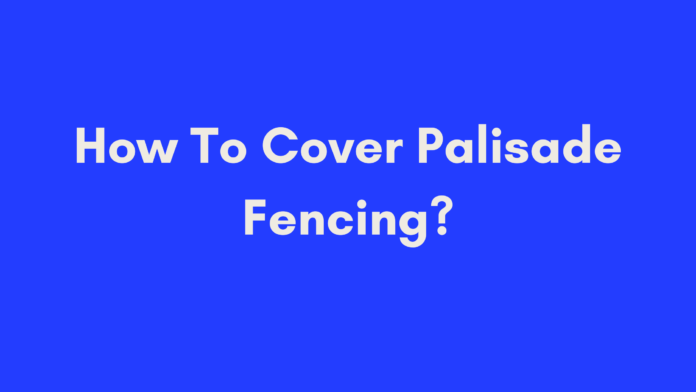Quick Summary
Covering your palisade fencing can transform both its appearance and functionality. Whether you’re aiming to improve aesthetics, increase privacy, or protect your fence from the elements, choosing the right material is key. Options include wood panels for a classic look, vinyl slats for durability, wrought iron covers for elegance, mesh netting for cost-effectiveness, and artificial ivy for a natural touch. Proper installation and regular maintenance are essential for achieving the best results. This guide provides a detailed look at why and how to cover your palisade fence, helping you make informed choices and avoid common pitfalls.
Introduction
Palisade fencing is a popular choice for security and boundary solutions, particularly in commercial and industrial settings. Its robust design offers an effective deterrent against intruders, making it a preferred option for protecting valuable property. However, while palisade fences serve a functional purpose, they may lack in aesthetics and privacy. This is where covering your palisade fencing can make a significant difference.
In this guide, we’ll explore the ins and outs of covering palisade fencing, from understanding what it is to the advantages it offers and the best methods for enhancing its appearance and functionality. Whether you’re looking to improve the look of your fence or increase its privacy and protection, this article will provide you with all the information you need.
What Is Palisade Fencing?
Palisade fencing is a type of metal fence known for its durability and security features. Typically constructed from metal posts and rails, this fencing style features upright pickets with pointed tips at the top. These sharp tips not only add to the fence’s intimidating appearance but also serve as a deterrent to potential intruders.
Key Features of Palisade Fencing
- Material: Usually made from steel or aluminum, palisade fences are known for their strength and resistance to damage.
- Design: The vertical pickets are often topped with pointed tips, which can vary in shape from sharp spikes to more decorative designs.
- Construction: The fence is anchored into the ground with metal posts and connected with horizontal rails, providing stability and durability.
Palisade fencing is commonly used around commercial properties, schools, and industrial sites in South Africa. Its design not only provides a physical barrier but also contributes to the overall security strategy of the property.
Advantages of Palisade Fencing
Palisade fencing offers several advantages that make it a preferred choice for many property owners. Here’s a closer look at its benefits:
High Security
- Intruder Deterrence: The pointed tips of the pickets make it difficult for intruders to climb over. This, combined with the metal’s strength, makes it a formidable barrier.
- Resistance to Cutting: Unlike other materials, such as wood or vinyl, metal palisade fences are not easily cut through with standard tools. This adds an extra layer of security.
Affordability
- Cost-Effective: Palisade fencing is relatively affordable compared to other security fencing options like electric or high-security fences. This makes it an attractive choice for budget-conscious property owners.
Durability
- Long Lifespan: With proper maintenance, palisade fences can last for several decades. The metal components are resistant to wear and tear, reducing the need for frequent repairs or replacements.
- Low Maintenance: Metal fences are less likely to suffer from issues like rot or insect damage, which are common in wooden fences.
Weather Resistance
- Performance in Various Conditions: Metal palisade fences can withstand harsh weather conditions, including heavy rain, strong winds, and intense sun. Unlike wood, they won’t rot or warp over time.
By understanding the benefits of palisade fencing, you can make an informed decision about whether it meets your security and aesthetic needs. In the following sections, we’ll explore how to cover your palisade fencing to enhance its appearance and functionality.
Reasons to Cover Palisade Fencing
Covering your palisade fencing can transform its functionality and appearance. Here are several compelling reasons why you might consider adding a cover to your palisade fence:
Enhancing Aesthetic Appeal
- Improving Visual Appeal: Palisade fences are primarily functional, but they may not always blend well with the surrounding environment. Adding a cover can soften the industrial look and make the fence more visually pleasing.
- Customization: Covers come in various styles and materials, allowing you to choose a design that complements your property’s aesthetic.
Increasing Privacy
- Creating a Private Space: Palisade fences offer limited privacy due to their open design. By covering them, you can block views into your property, creating a more secluded and private space.
- Enhancing Comfort: With improved privacy, you can enjoy your outdoor spaces without the feeling of being overlooked by neighbors or passersby.
Protecting Against Weather Damage
- Preventing Rust and Corrosion: Metal fences are susceptible to weather-related damage over time. Covers can provide an additional layer of protection against moisture, which helps to prevent rust and prolong the life of the fence.
- Shielding from UV Damage: Sun exposure can cause metal fences to heat up and deteriorate. Covers can shield the fence from UV rays, reducing the risk of damage and fading.
Adding Additional Features
- Incorporating Greenery: Some covers, such as artificial ivy or mesh netting, can support climbing plants and add a touch of nature to your fence. This not only enhances the look but also contributes to a more inviting atmosphere.
- Decorative Elements: Depending on the material you choose, you can add decorative elements to the fence, such as patterns, colors, or textures, that align with your personal taste.
How to Cover Palisade Fencing
Covering your palisade fencing involves several key steps, from measuring the fence to choosing the right materials and installation. Here’s a detailed guide to help you through the process:
Step 1: Measure Your Fence
- Tools and Techniques: Use a tape measure to determine the height and length of your fence. For accuracy, measure both straight sections and any curves or angles.
- Account for Gates and Openings: Ensure you measure around any gates or openings. You might need additional coverage for these areas to maintain uniformity.
Step 2: Choose Your Material
There are several options available for covering palisade fencing. Here’s a look at the most popular materials:
- Wood Panels:
- Pros: Natural look, customizable, easy to install.
- Cons: Requires maintenance, prone to weather damage without proper treatment.
- Vinyl Slats:
- Pros: Durable, low maintenance, available in various colors.
- Cons: Can be more expensive, less customizable.
- Wrought Iron Covers:
- Pros: Decorative, long-lasting, can be customized.
- Cons: Higher cost, requires maintenance to prevent rust.
- Mesh Netting:
- Pros: Cost-effective, easy to install, provides additional privacy.
- Cons: Less durable, may need replacement over time.
- Artificial Ivy:
- Pros: Enhances visual appeal, easy to install.
- Cons: May require periodic cleaning, less durable in harsh weather.
Step 3: Construct and Install the Covering
- Preparing Materials: Gather all necessary materials and tools based on your chosen covering type. Ensure that you have everything you need before starting the installation.
- Assembly Instructions: Follow the manufacturer’s instructions for assembling your chosen material. For example, if using wood panels, you may need to cut them to size and attach them with screws or nails.
- Installation Techniques: Secure the covering to the existing posts and rails using appropriate fasteners. Make sure the installation is stable and well-aligned to avoid any gaps or instability.
- Applying Sealant: For added protection, especially if you’re using materials like wood, apply caulk or sealant between edges to prevent moisture from seeping in and causing damage.
Step 4: Maintenance and Clean-Up
- Regular Inspection: Periodically check fasteners and coverings for signs of wear and tear. Tighten any loose screws or nails and address any issues promptly.
- Cleaning: Remove debris from the construction process using a broom or rake. Clean the covered fence according to the material’s maintenance requirements to keep it looking its best.
Materials for Covering Palisade Fencing
Choosing the right material for covering your palisade fencing is crucial for achieving both functionality and aesthetics. Here’s a comprehensive guide to the different materials you can use, each with its own set of advantages and considerations:
Wood Panels
- Description: Wood panels provide a classic and natural look. They can be custom cut and painted to match your style.
- Pros:
- Customizable: Can be painted or stained to suit your taste.
- Natural Appearance: Blends well with outdoor environments.
- Easy to Install: Typically straightforward to attach to existing fencing.
- Cons:
- Maintenance: Requires regular painting or staining to prevent rot and weather damage.
- Durability: May be less durable compared to metal options, especially in harsh weather conditions.
Vinyl Slats
- Description: Vinyl slats are a modern alternative to wood, offering a sleek and uniform appearance.
- Pros:
- Low Maintenance: Resistant to weather, rust, and insects.
- Durable: Long-lasting and retains color well.
- Variety: Available in different colors and styles.
- Cons:
- Cost: Can be more expensive than wood.
- Flexibility: Less customizable in terms of design and finish.
Wrought Iron Covers
- Description: Wrought iron offers a decorative and robust option for covering palisade fences.
- Pros:
- Aesthetic Appeal: Adds a touch of elegance and can be customized with intricate designs.
- Durability: Strong and resistant to physical damage.
- Longevity: Long-lasting with proper maintenance.
- Cons:
- High Cost: Typically more expensive due to the material and craftsmanship.
- Maintenance: Requires regular upkeep to prevent rust and corrosion.
Mesh Netting
- Description: Mesh netting is a practical solution that provides additional privacy and security.
- Pros:
- Cost-Effective: Generally less expensive than other options.
- Easy Installation: Simple to attach and adjust.
- Privacy: Effective at blocking views through the fence.
- Cons:
- Durability: May not last as long as more solid materials.
- Aesthetic: Less visually appealing compared to other options.
Artificial Ivy
- Description: Artificial ivy creates a green, natural look and can be easily attached to existing fences.
- Pros:
- Aesthetic Appeal: Adds a lush, green appearance to your fence.
- Easy Installation: Can be attached quickly and easily.
- Privacy: Provides some level of privacy and coverage.
- Cons:
- Durability: May require periodic cleaning and replacement.
- Weather Resistance: Can fade or degrade over time with exposure to the elements.
Tips for Effective Fence Covering
To ensure your fence covering project is successful and long-lasting, consider the following tips:
Choosing the Right Material for Your Needs
- Assess Your Goals: Determine whether you want to improve aesthetics, increase privacy, or protect your fence from weather damage.
- Match with Environment: Select materials that complement your property’s style and withstand local weather conditions.
Budget-Friendly Solutions
- DIY Options: Consider DIY installation if you’re comfortable with basic tools and techniques. This can save you money on labor costs.
- Compare Costs: Evaluate the cost of materials and installation to find the best value for your budget.
DIY vs. Professional Installation
- DIY: Ideal for simpler projects or if you have experience with similar tasks. Make sure to follow manufacturer instructions carefully.
- Professional Installation: Recommended for complex projects or if you prefer a hassle-free installation. Professionals can ensure proper alignment and durability.
Seasonal Considerations
- Best Times for Installation: Spring and fall are typically the best times for installation, as weather conditions are milder and more predictable.
- Maintenance: Regularly inspect your fence covering, especially after severe weather, to address any issues promptly.
Common Mistakes to Avoid
To achieve the best results and avoid issues, be aware of these common mistakes:
Overlooking Measurements
- Impact: Incorrect measurements can lead to gaps or insufficient coverage.
- Solution: Double-check all measurements before purchasing materials or starting installation.
Choosing Inappropriate Materials
- Issues: Using materials that don’t suit your needs or environment can result in poor performance or additional costs.
- Solution: Select materials based on their suitability for your specific requirements and local conditions.
Neglecting Maintenance
- Consequences: Lack of maintenance can lead to premature wear and damage, reducing the lifespan of your fence covering.
- Solution: Regularly inspect and maintain your fence covering according to the material’s requirements.
Conclusion
Covering your palisade fencing can significantly enhance both its appearance and functionality. By selecting the right materials and following the proper installation techniques, you can achieve a fence that not only serves its security purpose but also adds aesthetic value to your property. Whether you choose wood panels for a classic look, vinyl slats for durability, or artificial ivy for a touch of greenery, each option has its own set of benefits tailored to different needs and preferences.
Effective fence covering is more than just a cosmetic upgrade; it’s an investment in the longevity and performance of your fence. By understanding the reasons for covering your fence, choosing the right materials, and avoiding common mistakes, you can ensure a successful and satisfying result. Remember, regular maintenance is key to preserving the look and function of your fence covering for years to come.
Frequently Asked Questions
1. What is the best material for covering a palisade fence?
The best material depends on your specific needs and preferences. For a classic look, wood panels are a popular choice. Vinyl slats offer durability and low maintenance, while artificial ivy provides a natural aesthetic. Mesh netting is cost-effective and adds privacy, and wrought iron covers are decorative and robust.
2. How do I measure my fence for covering?
Measure the height and length of your fence using a tape measure. Be sure to account for any curves or angles and include measurements around gates or openings. This will help you determine how much material you need.
3. Can I install the fence covering myself?
Yes, many fence coverings can be installed as a DIY project, especially if you have basic tools and follow the manufacturer’s instructions. However, for complex installations or if you prefer a professional touch, hiring a contractor is recommended.
4. How often should I maintain my covered fence?
Regular maintenance is essential for longevity. Inspect your fence covering periodically, especially after severe weather, and address any issues such as loose fasteners or damage. Follow the specific maintenance guidelines for the material you’ve chosen.
5. Will covering my palisade fence affect its security?
Covering your palisade fence should not significantly impact its security if done correctly. Ensure that the covering is securely attached and does not create gaps or weaknesses that could compromise the fence’s effectiveness.
6. How long does it take to cover a palisade fence?
The time required for covering a palisade fence depends on the size of the fence, the type of material used, and whether you’re doing it yourself or hiring professionals. Typically, a DIY project may take a weekend, while professional installations could be completed in a few days.
7. What are the most common mistakes when covering a fence?
Common mistakes include incorrect measurements, using inappropriate materials, and neglecting regular maintenance. Ensure you measure accurately, choose suitable materials for your environment, and maintain the fence covering regularly to avoid these issues.
Author’s Note
Thank you for taking the time to read this comprehensive guide on covering palisade fencing. I hope this article has provided you with valuable insights and practical advice to help you make informed decisions about enhancing your fence.
As someone passionate about home improvement and outdoor aesthetics, I’ve found that a well-covered fence not only boosts the visual appeal of a property but also adds functionality and protection. Whether you’re a DIY enthusiast or considering professional help, I encourage you to carefully assess your needs and choose the materials and methods that best suit your goals.
If you have any further questions or need personalized advice, feel free to reach out. Your feedback and experiences are always welcome, and they help in creating even more helpful content in the future.
Happy fencing!

Oliver is a full-time writer with a passion for creating compelling content on diverse topics, including finance, business, product reviews, and more. With a keen eye for detail and a commitment to thorough research, she brings clarity and depth to complex subjects, making them accessible and engaging for readers. Oliver’s dedication to her craft ensures that every article is informative, well-researched, and thought-provoking. Outside of writing, she enjoys exploring new ideas, reading extensively, and continually expanding her knowledge.
Editorial Process
At Trusted Sources, our editorial process is crafted to ensure that every piece of content we produce—whether it’s an informational article or a review—meets the highest standards of accuracy, reliability, and engagement. Our commitment to delivering valuable, research-driven, and reader-centric content is reflected in our systematic and meticulous editorial approach.
Affiliate Disclosure
we are committed to transparency and honesty in all aspects of our operations, including our affiliate partnerships. We participate in various affiliate programs, which means we may earn commissions on qualifying purchases made through links on our Website.


